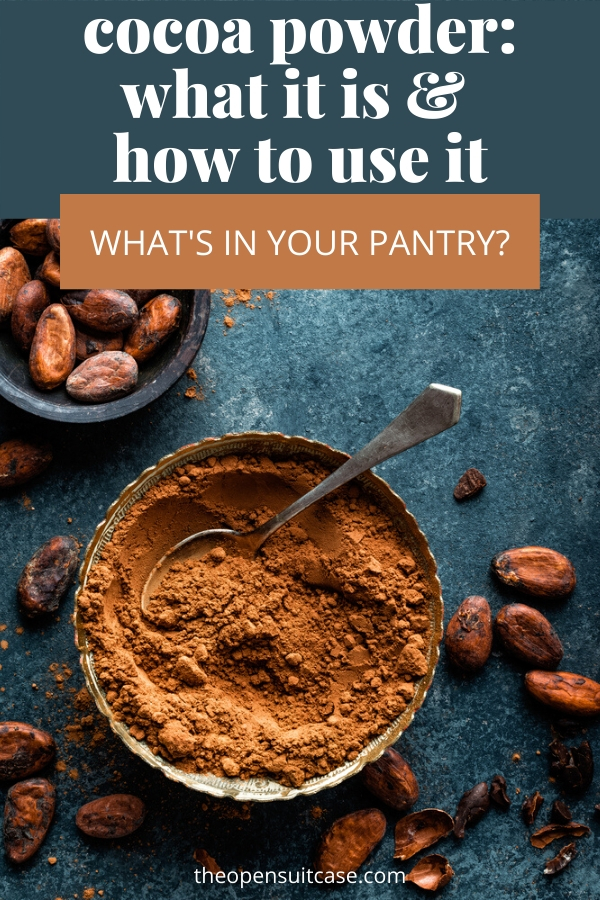Cocoa Powder: What it is and How to Use it
What did you find when you cleaned out your kitchen pantry? A half-empty bag of walnut pieces? Expired boxes of beef bone broth? How about cocoa powder? Wondering how it got there? Before you pitch it, read on to discover why this versatile kitchen staple deserves a place on your shelf.
During a recent pantry make-over, I found not one, but TWO unopened canisters of cocoa powder. Hmmmmm. I couldn’t remember purchasing them. They must have been ingredients in recipes I thought I’d make but never got around to actually making.
Or, “cocoa powder” was an item on a pantry staple list I consulted when we moved into our new house.I checked the expiration dates – still good – and put them back on the shelf. In the waaaay back.

With time on my hands thanks to the coronavirus confinement, I decided to revisit that cocoa powder. Why would it exist if it didn’t have a purpose?
I learned what it is, the difference between dutch process and natural cocoa powder and tested out my newly discovered pantry friend. To my surprise, I baked a better than decent chocolate cake, WITH frosting.
What is Cocoa Powder?
In a nutshell (bean pod, technically), cocoa powder is the pulverized version of cacoa beans, the remnants of chocolate production. Sold unsweetened, it’s the base ingredient in hot chocolate. But, wait! There’s more! When combined with sugar, shortening or other fats, it can replace familiar forms of chocolate such as Baker’s chocolate or semisweet chocolate chips.
Read More: Hot Chocolate in the Hudson Valley: Where to Warm Up this Winter
The Color of Money
We can thank ancient Mexican civilizations for learning the heart of cacoa cultivation and how to turn pods into chocolate. The Mayans drank their cocoa unsweetened but added the firepower of chilis to take it up a notch. And the Aztecs used cocoa beans as currency.
Dutch Cocoa Powder – It’s Not What You Think
You may be familiar with Droste cocoa powder. The package features a mysterious Flying Nun serving a cup of hot cocoa. It’s a bright red box, emblazoned with “Imported from Holland.”
Dutch cocoa.
But the Dutch doesn’t refer to the country of origin. “Dutching” is a process. An alkili is added to the cocoa powder, offsetting its natural acidity. Other brands of dutched cocoa powder include Guittard and Valhrona.
Is Natural Cocoa Powder Inferior?
If you’ve never really thought about cocoa powder, then you’ve probably purchased “natural” cocoa powder. Hershey’s is a popular and widely available brand.
And it gets the job done. For less money. A recent price check at my local Stop and Shop revealed Hershey’s cocoa powder was available at $.46 per ounce and Saco, a blend of natural and dutched cocoa powder at $.56 per ounce. Droste, on Amazon, cost $1.61 per ounce.
Beyond price differences, there are chemical differences between the products that may affect your final product, whether you’re making hot chocolate or brownies. If you want to take a really deep dive, check out the test kitchen at Cook’s Illustrated.
Health Benefits of Cocoa Powder
I’m not telling you to add a spoonful of cocoa to your daily intake of vitamins and supplements. But…there is evidence that cocoa is possibly effective in improving heart health by lowering blood pressure, according to WebMD.
And that’s good enough for me to continue to include cocoa in my diet – – – in moderation.
Recipes Featuring Cocoa Powder
Now that you’ve gone through your pantry and found the cocoa powder, it’s time to figure out what to make.
The answer, surprisingly, is almost anything you’ve made in the past with other forms of chocolate.
Chocolate Cake with Frosting
Want cake but have no eggs? No worries! If you’ve got cocoa powder on hand, you can whip up a treat called depression cake. Don’t let the name fool you. During the Depression, eggs were rationed but folks still craved sweets.
Combining cocoa powder with the usual suspects in cake-making – flour, sugar, salt, baking soda, oil – and, weirdly, vinegar, you can make a perfect 8″x8″ treat. This recipe for Chocolate Depression Cake includes an easy cocoa powder frosting that complements the cake. I tossed on some pastel M&Ms because, well, you can never have too much chocolate.

Hot Chocolate
For starters, try hot chocolate. You can’t go wrong with Alton Brown’s recipe to make a big batch of hot chocolate mix to keep on hand. That’s right, folks. It’s time to ditch the Swiss Miss. When making a mug of cocoa, Mr. Brown uses a handy Mexican moulinillo whisk. I’ll be buying several, mixing up some mix in mason jars and presenting them as Christmas gifts this year.
Note: Alton recommends using dutch cocoa powder for hot chocolate. I think it’s worth making the investment.
Brownies
My go-to brownie recipe is BAKER’S one bowl brownies. I’ve been making them for so long, I think I can bake them with my eyes closed. Well, almost. The trick to using cocoa powder in place of unsweetened chocolate squares is adding fat. The ratio is, generally, 3 tbsps of cocoa powder + 1 tbsp fat (butter, oil or shortening) = 1 ounce of unsweetened chocolate. Shortening? Guess what else I found in the back of my pantry?
Holy Mole Sauce
Sure. Cocoa powder works great when you’re making the sweet stuff. But what about savories? I love to order chicken in mole sauce when I find a good Mexican restaurant. But I’ve never tried to make it at home. Until now. I found this recipe for Mexican mole sauce that uses cocoa powder for the chocolate notes.
Got a favorite recipe featuring cocoa powder? Share it in the comments!
